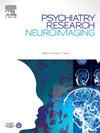The association between eye movement characteristics and cognitive function in adolescents with major depressive disorder
IF 2.1
4区 医学
Q3 CLINICAL NEUROLOGY
引用次数: 0
Abstract
Objective
This study aims to explore the relationship between eye movement characteristics and cognitive function in adolescents with major depressive disorder (MDD).
Method
EyeLink 1000 eye tracker was used to obtain eye movement data in free-viewing and smooth pursuit tasks. Chi-square test and Mann-Whitney test were used for inter-group comparison of demographic and clinical data. Spearman correlation was used to analyze the correlation between eye movement characteristics and cognitive function.
Results
Adolescents with MDD showed lower saccade amplitude in the free-viewing task and more fixations and saccades in the smooth pursuit task. In the free-viewing task, fixation count, saccade duration and saccade speed were found to be positively correlated with immediate memory and attention; fixation duration was negatively correlated with immediate memory. In the smooth pursuit task, saccade count was positively correlated with the faux pas test; fixation duration and saccade duration were significantly correlated with memory and attention.
Conclusion
Adolescents with MDD showed abnormalities in several indices of eye movement, and altered eye movement variables were also correlated with cognitive deficits. Eye-tracking technology helps illustrate the diverse cognitive strategies employed by individuals during cognitive tasks, allowing researchers to explore subtle differences in cognitive processes.
患有重度抑郁症的青少年眼球运动特征与认知功能之间的关联。
研究目的本研究旨在探讨患有重度抑郁症(MDD)的青少年的眼动特征与认知功能之间的关系:方法:使用EyeLink 1000眼动仪获取自由观看和平滑追逐任务中的眼动数据。采用卡方检验(Chi-square test)和曼-惠特尼检验(Mann-Whitney test)对人口统计学和临床数据进行组间比较。斯皮尔曼相关法用于分析眼动特征与认知功能之间的相关性:结果:患有 MDD 的青少年在自由观看任务中的眼球移动幅度较低,而在平滑追逐任务中的定点和眼球移动幅度较高。在自由观察任务中,固定次数、囊回持续时间和囊回速度与即时记忆和注意力呈正相关;固定持续时间与即时记忆呈负相关。在平滑追逐任务中,囊回次数与假动作测试呈正相关;定点持续时间和囊回持续时间与记忆力和注意力显著相关:结论:患有 MDD 的青少年在多个眼球运动指标上表现出异常,眼球运动变量的改变也与认知缺陷相关。眼动跟踪技术有助于说明个体在认知任务中采用的各种认知策略,使研究人员能够探索认知过程中的细微差别。
本文章由计算机程序翻译,如有差异,请以英文原文为准。
求助全文
约1分钟内获得全文
求助全文
来源期刊
CiteScore
3.80
自引率
0.00%
发文量
86
审稿时长
22.5 weeks
期刊介绍:
The Neuroimaging section of Psychiatry Research publishes manuscripts on positron emission tomography, magnetic resonance imaging, computerized electroencephalographic topography, regional cerebral blood flow, computed tomography, magnetoencephalography, autoradiography, post-mortem regional analyses, and other imaging techniques. Reports concerning results in psychiatric disorders, dementias, and the effects of behaviorial tasks and pharmacological treatments are featured. We also invite manuscripts on the methods of obtaining images and computer processing of the images themselves. Selected case reports are also published.

 求助内容:
求助内容: 应助结果提醒方式:
应助结果提醒方式:


